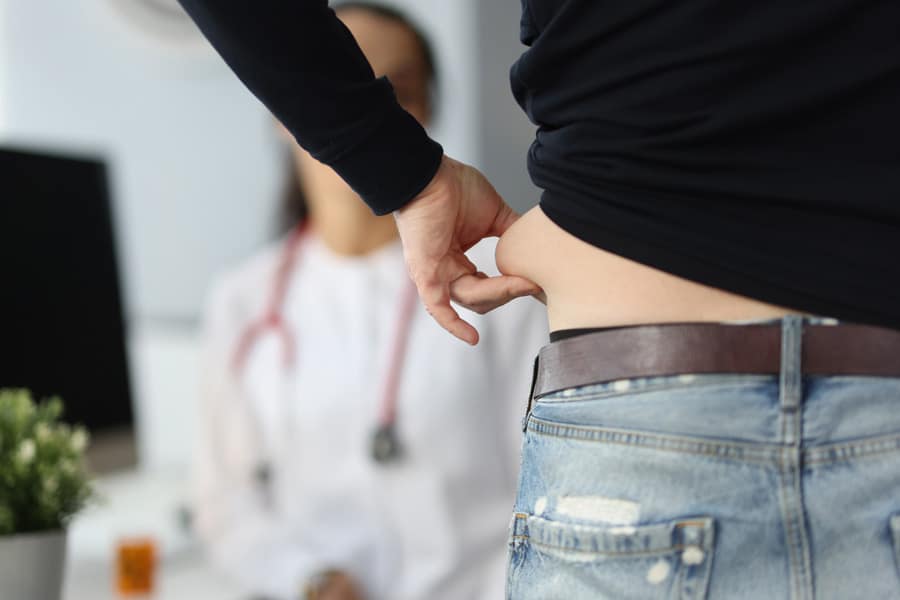Loose Skin Vs Fat: The Differences And Ways To Tighten The Skin

Loose skin vs fat | How to recognize | Causes | Tightening tips
When you lose weight rapidly, your skin may appear saggy and wrinkled due to excess skin. This excess skin is sometimes mistaken for having excess fat. In contrast, fat is a result of excessive weight gain.
In this article, we will discuss the difference between fat and loose skin, how to get rid of loose skin, and ways to tighten it.
Loose skin vs fat: the differences
There are key differences between loose skin and fat. Take a look at the differences below to understand how they vary from each other.
Loose skin
Loose skin, also known as extra skin, is the result of the loss of collagen and elastin. Collagen and elastin are the proteins that provide structure and elasticity to the skin.
Loose skin often appears wrinkled or saggy. It can occur anywhere on the body but is most commonly seen in areas that have lost significant amounts of fat, such as the face, neck, arms, and stomach.
Also, it can occur due to a number of factors, including aging, weight loss, or pregnancy.
Fat
Fat, on the other hand, is the fatty layer beneath the skin. Fat or subcutaneous fat is soft and saggy but not wrinkled like loose skin. This type of fat is stubborn and takes a great amount of effort and time to go away. Fat is sometimes mistaken for extra skin or loose skin.
How do you know if it is loose skin or fat?
To determine whether you have loose skin or fat, here’s a quick test to try:
The Pinch Test
Pinch the area between your thumb and forefinger, then observe the skin that you are pinching.
- Loose skin may feel thin and may not have much resistance when pinched. When pressed, loose skin may not “bounce back” or return to its original shape.
- If the area feels soft and “jiggly,” it is likely to be fat. Fat is usually soft and pliable and may feel “squishy” when pinched. When pressed, fat may bounce back or return to its original shape.
Causes of loose skin vs. causes of excess fat
There are various causes of loose skin and excess fat, ranging from natural processes such as aging and hormonal changes to lifestyle factors such as smoking.
Here is a comparison of the causes of loose skin and excess fat:
1. Genetics
Fat: Some people may have a genetic predisposition to gain weight more easily and store fat in certain areas of the body due to inherited characteristics. These genetic factors can affect a person’s metabolism, appetite, and the way the body processes and stores fats and sugars.
Loose Skin: If your parents have loose skin, you may also have it. While it’s not always hereditary, it is important for people who want to prevent loose skin to understand their personal risk factors for developing loose skin.
2. Age
Fat: As we age, we tend to lose muscle mass, which can lead to a slower metabolism. Consequently, our bodies become less efficient at burning fat stores to release energy. This leads to the accumulation of excess fat in the body.
Loose skin: Aging causes our skin becomes less elastic and makes it more prone to sagging. This is because the collagen and elastin fibers in the skin become less abundant and less effective at supporting the skin’s structure.
3. Pregnancy and childbirth
Fat: During pregnancy, the body undergoes hormonal changes that can cause the body to store more fat, particularly in the abdominal area. Additionally, after childbirth, it is common for women to have a period of time where they are not able to exercise much. This lack of physical activity can contribute to weight gain and excess fat.
Loose skin: The skin stretches to accommodate the growing baby during pregnancy. This stretching can cause the skin to become loose. Further, the body undergoes hormonal changes that can affect the production of proteins that support the structure and elasticity of the skin. All this translates into folds of loose skin after childbirth and post-pregnancy weight loss.
4. Hormonal changes
Fat: Hormonal changes can result in excess fat by disrupting the way the body processes and stores fats and sugars. Commonly known hormones that can cause excess fat accumulation are insulin, thyroid hormones, estrogen and progesterone, leptin, cortisol, and ghrelin.
Loose skin: Loose skin can be a result of hormonal fluctuations, as they can impact the production of collagen and elastin in the skin. An important hormone that sustains collagen production is estrogen. According to a study [1]National Library of Medicine: Effect of estrogens on skin aging and the potential role of SERMs, estrogen causes a reduction in skin elasticity. Therefore, leading to wrinkles and sagging.
5. Smoking
Fat: While smoking is not a direct cause of excess fat, it can contribute to weight gain and excess fat in some people by increasing appetite, causing stress, and decreasing physical activity.
Loose skin: Smoking has been observed to lead to a reduction in collagen production [2]PubMed: Tobacco smoke causes premature skin aging. This makes the skin lose its elasticity and causes it to droop.
Weight Loss
Rapid weight loss can cause the skin to become loose, especially if a large amount of weight has been lost in a short period of time.
How to lose fat and tighten the loose skin?
Losing fat and tightening loose skin are two of the most stubborn problems individuals have been facing in this obesity-ridden world.
There are ways to lose fat and tighten loose skin naturally, which are listed below:
1. Exercise
Engaging in cardiovascular exercises, such as running, cycling, or swimming, can help you burn calories and reduce fat. Loose skin after a fat loss can be reduced with muscle strengthening and resistance training.
It takes at least 4 weeks to see the results. Therefore, you must be patient and go at a pace comfortable to you.
2. Stay hydrated
Water is crucial for our body, especially for our skin’s elasticity and hydration. Drinking water can help keep you feeling full and can also help you burn fat. In addition, proper hydration can improve suppleness, reduce wrinkles and promote skin elasticity.
3. Consume nutrient-rich diet
Consuming nutrients can help with collagen production and boost skin elasticity:
- Vitamin C: Vitamin C is necessary for the formation of collagen [3]National Library of Medicine: The Roles of Vitamin C in Skin Health. Vitamin C supports collagen gene expression and functions as a co-factor for the proline and lysine hydroxylases. Proline and lysine are amino acids that help stabilize the tertiary structure of the collagen molecule.
- Zinc: Studies have shown that zinc [4]PubMed: Influence of zinc on synthesis and the accumulation of collagen in early granulation tissue may help to improve the health and appearance of the skin, including reducing the appearance of wrinkles and improving skin elasticity.
- Protein: Protein has a high thermic effect [5]National Library of Medicine: A high-protein diet for reducing body fat: mechanisms and possible caveats, which helps boost your metabolism and increase the number of calories you burn each day. Protein is necessary for the maintenance and repair of tissues, including muscle. Maintaining and building muscle mass is important for fat loss because muscle burns more calories at rest. By consuming enough protein, you can help preserve muscle mass while you lose fat.
4. Get enough sleep
Getting enough sleep can be important for fat loss because it can help regulate your appetite and metabolism.
During sleep, your body burns calories to support vital functions such as heart rate, brain activity, and muscle repair. Your body uses energy from your stored fats and carbohydrates to fuel these processes. Therefore, getting enough sleep can help your body burn stored fat.
5. Massage
The loose skin can be massaged to promote blood flow and an anti-aging reaction. If the skin is loose somewhere, you can use olive oil or castor oil to massage it gently.
Conclusion
It is easy to recognize loose skin as it is wrinkled and can be pinched. Fat, on the other hand, has a tighter and more packed appearance.
It is understandable that losing extra fat and getting rid of loose skin is tough. However, the aforementioned tips will help you to shed fat and tighten loose skin without any surgical procedures or products.
References
| ↑1 | National Library of Medicine: Effect of estrogens on skin aging and the potential role of SERMs |
|---|---|
| ↑2 | PubMed: Tobacco smoke causes premature skin aging |
| ↑3 | National Library of Medicine: The Roles of Vitamin C in Skin Health |
| ↑4 | PubMed: Influence of zinc on synthesis and the accumulation of collagen in early granulation tissue |
| ↑5 | National Library of Medicine: A high-protein diet for reducing body fat: mechanisms and possible caveats |







